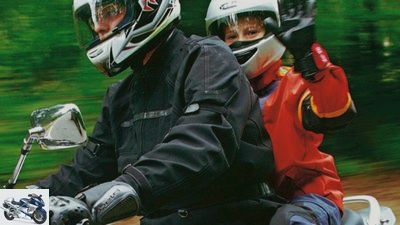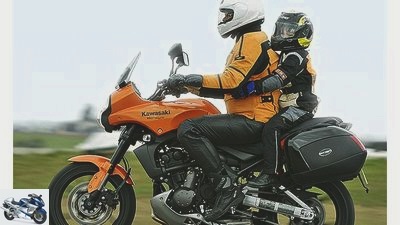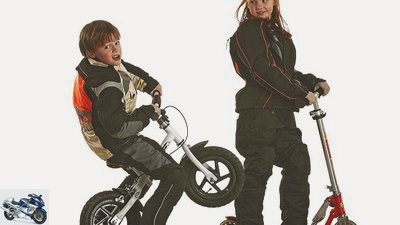Table of contents
- That’s how it’s done Tours with children
- Basics
- requirements
- Protective clothing
- Suitable motorcycles

archive
counselor
workshop
How it works: tours with children
That’s how it’s done
Tours with children
When dad comes back beaming with joy on a Saturday after his tour, it is only a matter of time before the youngsters want to go too. Then there are just a few things to consider and nothing stands in the way of having fun driving together.
Mathias Heerwagen
07/29/2010
Like everything in Germany, the transport of people on motorcycles is comprehensively regulated by law. In the Road Traffic Licensing Regulations (StVZO) it says in § 61: “Two-wheeled vehicles on which a passenger may be transported must be equipped with a holding system for the passenger (…)”. Holding onto daddy’s jacket is not enough to take the little ones for a spin. Those who do not have grab handles on their motorcycle are not allowed to take a pillion passenger with them. In addition, it is legally stipulated that footrests must be available for both the driver and the front passenger – free dangling children’s feet are taboo. Of course, the motorcycle must be equipped with a seat for the passenger. But there are exceptions: “This does not apply to taking a child under the age of seven with you, if there is a special seat for the child and wheel covers or other equally effective devices ensure that the child’s feet cannot get caught in the spokes” ( StVZO § 35/9).
Basics

archive
If all requirements are met, nothing stands in the way of your journey.
So that the youngsters arrive at their destination safe and sound and want to continue riding in the future, you should take a few basic things to heart.
- Always ride with appropriate, suitable protective clothing.
- Avoid unnecessarily hard acceleration and braking maneuvers because children have less strength and find it difficult to hold on.
- Do not drive on extreme lean angles because the little ones can be afraid of tipping over.
- Take frequent breaks, as children do not yet have great stamina and tire quickly.
- If possible, use the intercom so that the youngsters feel safer and have a contact person.
requirements
After the legal requirements have been met, things can actually start, right? Not quite. Because everything has to be in order not only legally. Small children are often physically and mentally incapable of following what is happening on a motorcycle. A three-year-old will hardly be able to stay on the motorcycle on his own. Since there is no catalog that prescribes what a child must be able to do to ride a motorcycle, there can be trouble at police checks. Ultimately, it is the responsibility of the parents to determine from what age the child is allowed to ride. Traffic psychologists advise not to take children with you until they are elementary school, as there is a big leap in development from around the age of eight, the little ones can concentrate longer and are physically fitter. However, you should not use them for more than an hour in each direction and take a short break about every 20 minutes. From the age of twelve, day tours are also possible without any problems. Basically, if you are not sure whether the offspring is ready, it is better to wait another year instead of taking unnecessary risks.
Protective clothing

archive
Children can only ride safely with the right protective clothing.
Just like adults, children should always wear appropriate protective clothing on a motorcycle. Suitable pants, jacket, boots and gloves are part of the basic equipment. A back protector protects the spine in the event of an accident. Of course, the clothing must fit correctly so that the protectors do not slip in the event of a fall. Since children have less fat tissue, they cool down faster on the motorcycle – long functional underwear is recommended here. There are now many products especially for children, but caution is advised. In the case of helmets, it can happen that a helmet shell is used for adults and is only padded to the size of a child. However, this increases the risk of being wiped off in the event of an accident. The helmet weight also plays an important role. Children have fewer neck and throat muscles and can hardly wear a heavy helmet in the long term. The following applies here: The helmet should be as light as possible, even if it is a little more expensive. There are also problems with retrofittable CE protectors. They are mostly designed for the weight of an adult. If a child wears such a protector in an accident, it responds very slowly because of the lower body weight because it is not soft enough. Parents should definitely buy protectors made specifically for children.
Suitable motorcycles
Do you have a super sports car in your garage and your youngest one really wants to go on tour? The initial enthusiasm will probably quickly vanish into thin air. Because not every motorcycle is equally suitable for a pillion passenger. The little ones sit more badly than right, especially on super sports bikes: thin seat cushions offer little support, high passenger pegs are also uncomfortable for small passengers. Sometimes strong vibrations remove the last bit of driving fun. All-rounders, tourers or cruisers are the perfect vehicles when it comes to relaxed tours with children. Your seats are flat, large and comfortable. A possibly installed case system with top case provides the little ones with an additional feeling of security and the opportunity to lean against. As a driver you don’t have to worry about rough performance, and the children don’t have to hold on tightly.
Top
- Tourer
- Cruiser
- All-rounder
Flop
- Super athlete
- Enduro
Related articles
-
Advice: children as passengers
Instead of telly or computer, go outside on a journey together! motorcycles Advice: children as passengers Advice: children as passengers Kids and…
-
to travel Traveling with children Traveling with children Children of men Traveling with children is not an easy thing for motorcycle parents. But…
-
fact clothing Station wagons, jackets & pants Children on the motorcycle Children on the motorcycle Kid stuff Can the child go on a motorcycle? A…
-
Buell to travel Buell Tours Buell Tours Man thing Buell’s advertising text is clear: “The difference between primitive mechanics and soulless…
-
Cook to travel Trips, tours, trips 2013 Excursions, tours, travel 2013 – tips for great experiences Seven dreams The same every year. If you look back,…
-
MV Agusta children’s balance bike made of wood
MV Agusta 8th pictures MV Agusta 1/8 MV Agusta launches a wooden balance bike. MV Agusta 2/8 The younger you are, the closer you are to the means of…
-
Motorcycle tours are not prohibited in lockdown
Klaus H. Daams 16 pictures Getty Images 1/16 Baden-Wurttemberg: Contact restriction – jaunts allowed. Getty Images 2/16 Bavaria: Exit restriction -…
-
ADAC E-Kids Cup – electric trial competition series for children
Jorg Kunstle Sports & scene Motorsport ADAC E-Kids Cup – electric trial competition series for children ADAC E-Kids Cup for young trial riders…
-
Competition – Schuberth is giving away five motorcycle tours and R2 full-face helmets
Schuberth 15th pictures Schuberth 1/15 Schuberth R2. Schuberth 2/15 Schuberth R2. Schuberth 3/15 Schuberth C4. Schuberth 4/15 Schuberth C4. Schuberth…
-
RIDE – exclusive motorcycle tours to download and descendants
Tour tips Exclusive motorcycle tours for children to follow Presented by Dirk Schafer to travel RIDE – exclusive motorcycle tours to download and…